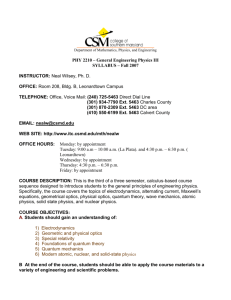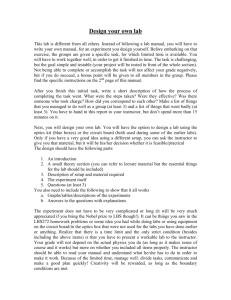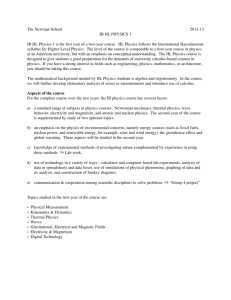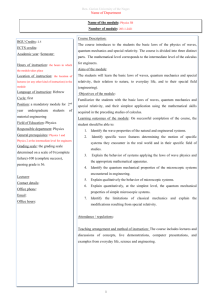College of Southern Maryland PHY 2210 – General Engineering
advertisement
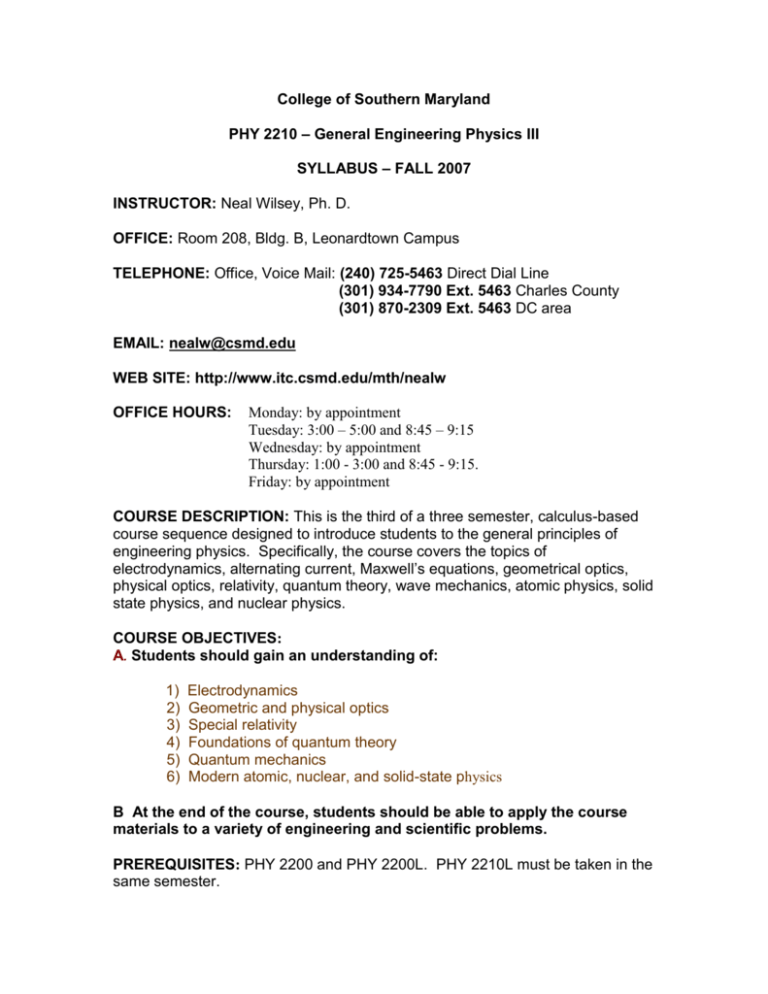
College of Southern Maryland PHY 2210 – General Engineering Physics III SYLLABUS – FALL 2007 INSTRUCTOR: Neal Wilsey, Ph. D. OFFICE: Room 208, Bldg. B, Leonardtown Campus TELEPHONE: Office, Voice Mail: (240) 725-5463 Direct Dial Line (301) 934-7790 Ext. 5463 Charles County (301) 870-2309 Ext. 5463 DC area EMAIL: nealw@csmd.edu WEB SITE: http://www.itc.csmd.edu/mth/nealw OFFICE HOURS: Monday: by appointment Tuesday: 3:00 – 5:00 and 8:45 – 9:15 Wednesday: by appointment Thursday: 1:00 - 3:00 and 8:45 - 9:15. Friday: by appointment COURSE DESCRIPTION: This is the third of a three semester, calculus-based course sequence designed to introduce students to the general principles of engineering physics. Specifically, the course covers the topics of electrodynamics, alternating current, Maxwell’s equations, geometrical optics, physical optics, relativity, quantum theory, wave mechanics, atomic physics, solid state physics, and nuclear physics. COURSE OBJECTIVES: A. Students should gain an understanding of: 1) 2) 3) 4) 5) 6) Electrodynamics Geometric and physical optics Special relativity Foundations of quantum theory Quantum mechanics Modern atomic, nuclear, and solid-state physics B At the end of the course, students should be able to apply the course materials to a variety of engineering and scientific problems. PREREQUISITES: PHY 2200 and PHY 2200L. PHY 2210L must be taken in the same semester. CREDIT HOURS: 3 CLASS SESSIONS: Section 50955, Monday and Wednesday 7:05 – 8:30 p.m. WEB ENHANCEMENT: WebCT is a convenient internet-based software package (provided free of charge to the student) and one of many tools we will utilize this semester. During the semester, the instructor will be using WebCT to post bulletins, send and receive email, post answer keys and occasionally post assignments. WebCT is designed to enhance the course, but not meant to substitute for class sessions. You are required to attend class as usual. If you have any questions or concerns about WebCT, please contact the instructor as soon as possible. TEXT: Physics for Scientists and Engineers - with Modern Physics by Raymond A. Serway and John W. Jewett, 6th Edition (Required) Study Guide and Students’ Solution Manual by Van Wyk, McGrew, Gordon, and Serway (Optional) CALCULATOR: Graphing Calculator (Required) TI-83, TI-83+ and TI 84+ Supported PERFORMANCE EVALUATION: Student performance will be measured as follows: 3 unit exams (non-comprehensive – see attached schedule): 25 % each, 75% total. 6 quizzes (non-comprehensive, unscheduled). The lowest quiz score will be dropped. 4% each, 20 % total. Class participation 5%. Students will be required to ask a question, answer a question or present a homework solution at each class meeting. Final grades will be assigned as follows: 90 – 100% A 80 – 89% B 70 – 79% C 60 – 69% D Below 60% F HOMEWORK: Homework will be assigned in class. Successful independent completion of the homework assignment serves as an invaluable aid in understanding the concepts presented in the course. Students should be prepared to present homework solutions in class on the due date. ATTENDANCE POLICY: Attendance will be taken at each class session. Each student is responsible for any and all announcements, assignments, lectures, materials, handouts, and scheduled exams presented during the class session. AUDIT AND WITHDRAWAL POLICY: Students are reminded to consult the College Catalog for dates, procedures, responsibilities and impacts of changing registration status. November 16 is the last day to withdraw from a course or change from AUDIT status to CREDIT status or from CREDIT to AUDIT. Change from credit to audit status requires a written contract between the student and instructor. The contract must be in place prior to November 16. Students who fail to adhere to the terms of the contract will receive a grade of WD. MAKEUP EXAM POLICY: Makeup exams will be allowed without penalty for legitimate reasons if the instructor is notified in advance or if an emergency occurs. Quizzes will be available online at the course WEB-CT site as scheduled by the instructor. All quizzes must be completed within the time allocated. All makeup exams will be administered in the instructor’s office or in the Testing Center and will be scheduled by the instructor. STUDENT INTEGRITY POLICY: Students are expected to perform independently on exams and quizzes without the use of unauthorized materials (unauthorized notes, etc.). Any violations of the Student Code of Conduct as outlined in the Student Handbook result in a score of zero for the exam or quiz. The violation will be reported to the Director of Student Affairs and to the College Judicial Committee for review and possible disciplinary action. DISABILITIES AND SPECIAL NEEDS: Students with disabilities who believe they may need accommodations in this class are encouraged to contact Disabled Student Services in the Learning Assistance Department at 301.934.7614 as soon as possible to better ensure that such accommodations are implemented in a timely fashion. UNAUTHORIZED PERSONS: Unauthorized persons (children, friends, family members, and any other persons not registered for the course) are not allowed in the classroom. Details of this college policy can be found in the Student Handbook. COURSE OUTLINE: PHY 2210 – Fall, 2006 SESSION DATE SUBJECT TEXT SECTION Homework Review of Electric and Magnetic Fields 1 8/28 1&2 8/28 & 8/30 3&4 4&5 9/6 & 9/11 9/11&9/13 6 9/18 7 9/20 Introduction to Electromagnetism Faraday's Law: Faraday's law of induction; Motional emf; Lenz's law; Induced emfs and electric fields; Maxwell's wonderful equations Inductance: Self-inductance; RL circuits; Energy in a magnetic field; Mutual inductance; Oscillations in an LC circuit; The RLC circuit Alternating Current Circuits: ac sources; Resistors in an ac circuit; Inductors in an ac circuit; Capacitors in an ac circuit; Power in an ac circuit; Resonance in a Series RLC circuit; Filter circuits; The transformer and Power Transformer Electromagnetic Waves: Maxwell’s equations and Hertz’s discoveries; Plane electromagnetic waves; Energy carried by electromagnetic waves; Momentum and radiation pressure; Radiation from an infinite current sheet; The production of electromagnetic waves by an antenna; The spectrum of electromagnetic waves Review Review PHY 2200 Materials and Reread Chapters 29 and 30 before class. 31.1 – 31.4 31.7 5, 7, 13, 15, 21, 33, 37, 45, 47, 57 32.1 – 32.6 1, 3, 7, 17, 21, 29, 33, 35, 47, 57, 71 33.1 – 33.9 1, 5, 9, 11, 17, 19, 23, 25, 29, 32, 37, 45, 49, 55 34.1 – 34.4 34.7 5, 9, 15, 17, 25, 29, 33, 35, 51 31 – 34 8 9 & 10 10 &11 9/25 9/27 &10/2 10/2 &10/4 12 & 13 10/9 &10/11 14 10/16 Unit #1 Test The Nature of Light and the Laws of Geometric Optics: The nature of light; Measurements of the speed of light; The ray approximation in geometric optics; Reflection and refraction; Dispersion and prisms; Huygens’s principle; Total internal reflection; Geometric Optics: Images formed by flat mirrors; Images formed by spherical mirrors; Images formed in refraction; Thin lenses; Interference of Light Waves: Conditions for Interference; Young’s double-slit experiment; Intensity distribution of the double-slit interference pattern; Phasor addition of waves; Change of phase due to reflection; Interference in thin films; The Michelson interferometer Diffraction and Polarization: Introduction to diffraction; Single-slit diffraction; Resolution of single-slit and circular apertures; The diffraction grating; Polarization of light waves. 31 - 34 35.1-35.8 1, 3, 7, 11, 19, 29, 31, 32, 37, 47, 53, 55, 61, 36.1 – 36.4 1, 3, 9, 15, 19, 21, 27, 31, 37, 45, 45, 51, 63, 65, 37.1 – 37.7 1, 3, 5, 7, 11, 15, 21, 29, 37, 41, 51, 65 38.1 – 38.4 38.6 1, 3, 13, 15, 17, 18, 25, 29, 33, 37, 45, 46 15 10/18 Review of Unit II 37 – 38 16 10/23 Unit II Test 35 – 38 17 & 18 10/25 and 10/30 19 and 20 11/ 1 and 11/6 20 and 21 11/5 and 11/8 22 and 23 11/13 and 11/15 23&24 11/15 &11/20 25 11/27 Relativity: The principle of Newtonian relativity; The Michelson-Morley experiment; Einstein's principle of relativity; Consequences of special relativity; The Lorenz transformation equation; Relativistic momentum and the relativistic form of Newton's laws; Relativistic energy; Equivalence of mass and energy; Relativity and electromagnetism. Introduction to Quantum Mechanics: Blackbody radiation and Planck's hypothesis; The Photoelectric effect; The Compton effect; Atomic spectra; Bohr's Quantum model of the atom; Photons and electromagnetic waves; The wave properties of particles Quantum Mechanics: Double slit Experiment; Uncertainty principle; Probability density; Particle in a box; Schrödinger Equation, Particle in a Well of Finite Height; Tunneling Through a Barrier Atomic Physics: Early models of the atom; The hydrogen atom revisited; Spin magnetic quantum number; Wave functions for hydrogen; Other quantum numbers; The Pauli exclusion principle and building the periodic table; Atomic spectra; Atomic Transitions; Lasers Molecules and Solids: Molecular bonds; Molecular Spectra, Bonding in Solids; Band Theory of Solids; Free Electron Theory of Metals; Electrical Conduction; Semiconductor Devices Nuclear Structure Some Properties of Nuclei, Binding Energy, Models, Radioactivity, Decay Processes, Natural Radioactivity, Nuclear Reactions, Nuclear Magnetic Resonance and NMI 39.1 - 39.9 1, 3, 9, 11, 14, 23, 31, 33, 35, 43, 49, 53 40.1 - 40.7 1, 3, 7, 9, 17, 19, 27, 31, 37, 41, 57, 65 41.1 - 41.7 1, 3, 5, 9, 15, 17, 23, 37 42.1 - 42.9 5, 11, 17, 49, 50 43.1 – 43.7 1, 3, 7, 11, 21, 35, 38 44.1 – 44.8 3, 29, 33 26 27 & 28 29 30 11/29 12/4 & 12/6 12/11 12/13 Applications of Nuclear Physics: Interactions Involving Neutrons, Nuclear Fission, Nuclear Reactors, Nuclear Fusion, Radiation Damage, Radiation Detectors 45.1 – 45.7 Particle Physics and Cosmology: The Fundamental Forces in Nature, Positrons and Other Antiparticles, Mesons & Particle Physics, Classification of Particles, Conservation Laws, Strange Particles and Strangeness, Patterns, Quarks, The Standard Model, Cosmology, Problems and Perspectives 46.1 – 46.13 11, 19, 43 1, 13, 17, 27, Review of Unit III 39 - 43 Unit III Exam 31 – 43

